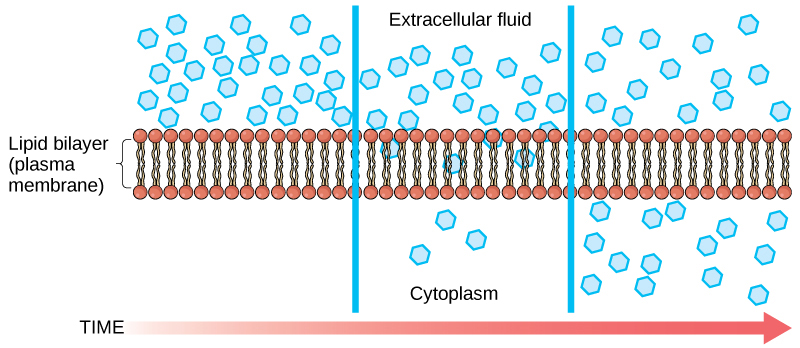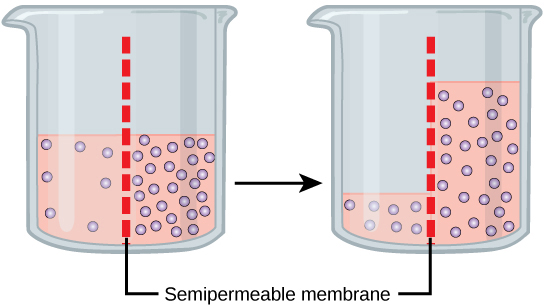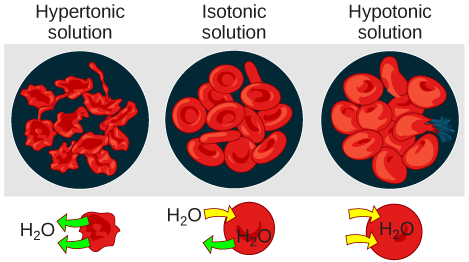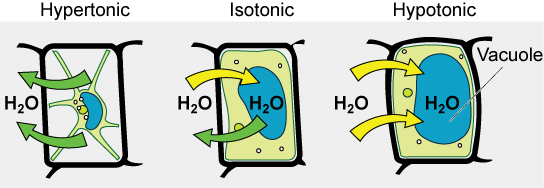Three Types Of Passive Transport
Chapter iii: Introduction to Cell Structure and Function
3.5 Passive Send
By the finish of this section, you will be able to:
- Explain why and how passive transport occurs
- Sympathize the processes of osmosis and diffusion
- Define tonicity and describe its relevance to passive transport
Plasma membranes must allow certain substances to enter and get out a cell, while preventing harmful material from entering and essential material from leaving. In other words, plasma membranes are selectively permeable—they allow some substances through but not others. If they were to lose this selectivity, the cell would no longer be able to sustain itself, and information technology would exist destroyed. Some cells crave larger amounts of specific substances than do other cells; they must have a mode of obtaining these materials from the extracellular fluids. This may happen passively, equally certain materials movement back and forth, or the cell may have special mechanisms that ensure send. About cells expend most of their energy, in the class of adenosine triphosphate (ATP), to create and maintain an uneven distribution of ions on the opposite sides of their membranes. The structure of the plasma membrane contributes to these functions, just it too presents some issues.
The near direct forms of membrane transport are passive. Passive transport is a naturally occurring phenomenon and does not require the jail cell to expend free energy to accomplish the movement. In passive ship, substances move from an surface area of higher concentration to an area of lower concentration in a process called improvidence. A physical infinite in which there is a different concentration of a single substance is said to accept a concentration gradient.
Selective Permeability
Plasma membranes are asymmetric, significant that despite the mirror image formed by the phospholipids, the interior of the membrane is not identical to the exterior of the membrane. Integral proteins that act equally channels or pumps work in ane direction. Carbohydrates, fastened to lipids or proteins, are also found on the exterior surface of the plasma membrane. These sugar complexes help the jail cell bind substances that the prison cell needs in the extracellular fluid. This adds considerably to the selective nature of plasma membranes.
Recall that plasma membranes have hydrophilic and hydrophobic regions. This feature helps the movement of certain materials through the membrane and hinders the movement of others. Lipid-soluble textile tin easily slip through the hydrophobic lipid core of the membrane. Substances such as the fat-soluble vitamins A, D, East, and K readily laissez passer through the plasma membranes in the digestive tract and other tissues. Fat-soluble drugs besides gain easy entry into cells and are readily transported into the body's tissues and organs. Molecules of oxygen and carbon dioxide have no charge and laissez passer through by elementary improvidence.
Polar substances, with the exception of water, nowadays problems for the membrane. While some polar molecules connect easily with the outside of a cell, they cannot readily pass through the lipid core of the plasma membrane. Additionally, whereas small ions could easily slip through the spaces in the mosaic of the membrane, their charge prevents them from doing so. Ions such as sodium, potassium, calcium, and chloride must have a special ways of penetrating plasma membranes. Simple sugars and amino acids as well need help with send across plasma membranes.
Diffusion
Diffusion is a passive procedure of transport. A single substance tends to move from an area of loftier concentration to an area of low concentration until the concentration is equal beyond the space. Y'all are familiar with diffusion of substances through the air. For case, call back well-nigh someone opening a bottle of perfume in a room filled with people. The perfume is at its highest concentration in the bottle and is at its everyman at the edges of the room. The perfume vapor will lengthened, or spread away, from the bottle, and gradually, more and more than people volition smell the perfume every bit it spreads. Materials move within the prison cell's cytosol by diffusion, and certain materials move through the plasma membrane by diffusion (Figure 3.24). Diffusion expends no energy. Rather the unlike concentrations of materials in unlike areas are a grade of potential energy, and diffusion is the dissipation of that potential energy as materials move down their concentration gradients, from high to depression.

Each dissever substance in a medium, such as the extracellular fluid, has its own concentration slope, independent of the concentration gradients of other materials. Additionally, each substance will diffuse according to that gradient.
Several factors affect the rate of improvidence.
- Extent of the concentration gradient: The greater the difference in concentration, the more rapid the diffusion. The closer the distribution of the material gets to equilibrium, the slower the rate of improvidence becomes.
- Mass of the molecules diffusing: More massive molecules move more than slowly, considering it is more hard for them to move between the molecules of the substance they are moving through; therefore, they lengthened more slowly.
- Temperature: Higher temperatures increment the energy and therefore the movement of the molecules, increasing the rate of improvidence.
- Solvent density: As the density of the solvent increases, the rate of diffusion decreases. The molecules slow down because they have a more hard time getting through the denser medium.
Concept in Activity
For an animation of the diffusion process in action, view this brusque video on jail cell membrane transport.

Facilitated send
In facilitated send, besides called facilitated improvidence, material moves across the plasma membrane with the assistance of transmembrane proteins down a concentration gradient (from high to low concentration) without the expenditure of cellular energy. However, the substances that undergo facilitated transport would otherwise not diffuse hands or chop-chop across the plasma membrane. The solution to moving polar substances and other substances across the plasma membrane rests in the proteins that span its surface. The textile being transported is commencement attached to protein or glycoprotein receptors on the exterior surface of the plasma membrane. This allows the fabric that is needed by the jail cell to be removed from the extracellular fluid. The substances are then passed to specific integral proteins that facilitate their passage, because they form channels or pores that let certain substances to pass through the membrane. The integral proteins involved in facilitated transport are collectively referred to equally send proteins, and they function every bit either channels for the material or carriers.
Osmosis
Osmosis is the diffusion of water through a semipermeable membrane according to the concentration gradient of water across the membrane. Whereas diffusion transports material across membranes and within cells, osmosis transports only water across a membrane and the membrane limits the improvidence of solutes in the water. Osmosis is a special case of diffusion. Water, like other substances, moves from an expanse of higher concentration to ane of lower concentration. Imagine a chalice with a semipermeable membrane, separating the two sides or halves (Figure three.25). On both sides of the membrane, the h2o level is the same, simply there are different concentrations on each side of a dissolved substance, or solute, that cannot cantankerous the membrane. If the volume of the water is the same, just the concentrations of solute are different, then at that place are too different concentrations of h2o, the solvent, on either side of the membrane.

A principle of improvidence is that the molecules move around and volition spread evenly throughout the medium if they can. However, only the material capable of getting through the membrane will diffuse through it. In this example, the solute cannot diffuse through the membrane, but the h2o can. Water has a concentration gradient in this system. Therefore, h2o will diffuse down its concentration gradient, crossing the membrane to the side where information technology is less concentrated. This diffusion of h2o through the membrane—osmosis—volition continue until the concentration gradient of water goes to zero. Osmosis gain constantly in living systems.
Tonicity
Tonicity describes the amount of solute in a solution. The mensurate of the tonicity of a solution, or the full amount of solutes dissolved in a specific amount of solution, is called its osmolarity. Three terms—hypotonic, isotonic, and hypertonic—are used to relate the osmolarity of a cell to the osmolarity of the extracellular fluid that contains the cells. In a hypotonic solution, such as tap water, the extracellular fluid has a lower concentration of solutes than the fluid inside the cell, and water enters the cell. (In living systems, the point of reference is always the cytoplasm, then the prefix hypo– means that the extracellular fluid has a lower concentration of solutes, or a lower osmolarity, than the cell cytoplasm.) It too means that the extracellular fluid has a college concentration of water than does the prison cell. In this situation, water will follow its concentration slope and enter the prison cell. This may cause an animal cell to burst, or lyse.
In a hypertonic solution (the prefix hyper– refers to the extracellular fluid having a higher concentration of solutes than the cell's cytoplasm), the fluid contains less h2o than the cell does, such as seawater. Because the jail cell has a lower concentration of solutes, the water volition leave the cell. In effect, the solute is drawing the water out of the jail cell. This may crusade an animal cell to shrivel, or crenate.
In an isotonic solution, the extracellular fluid has the same osmolarity as the cell. If the concentration of solutes of the cell matches that of the extracellular fluid, at that place will be no net move of h2o into or out of the cell. Blood cells in hypertonic, isotonic, and hypotonic solutions accept on characteristic appearances (Effigy 3.26).

A doctor injects a patient with what the doc thinks is isotonic saline solution. The patient dies, and dissection reveals that many ruby blood cells have been destroyed. Do you think the solution the doctor injected was actually isotonic?
<!– No, information technology must have been hypotonic, as a hypotonic solution would cause water to enter the cells, thereby making them outburst. –>
Some organisms, such as plants, fungi, leaner, and some protists, take cell walls that surround the plasma membrane and prevent cell lysis. The plasma membrane can but expand to the limit of the cell wall, so the prison cell will non lyse. In fact, the cytoplasm in plants is always slightly hypertonic compared to the cellular environment, and water will e'er enter a cell if water is bachelor. This influx of h2o produces turgor pressure, which stiffens the prison cell walls of the plant (Figure 3.27). In nonwoody plants, turgor pressure supports the establish. If the plant cells become hypertonic, every bit occurs in drought or if a plant is not watered adequately, h2o will leave the cell. Plants lose turgor pressure in this condition and wilt.

Section Summary
The passive forms of send, improvidence and osmosis, motion material of small molecular weight. Substances diffuse from areas of high concentration to areas of depression concentration, and this process continues until the substance is evenly distributed in a organisation. In solutions of more than one substance, each type of molecule diffuses co-ordinate to its own concentration gradient. Many factors can bear on the rate of diffusion, including concentration gradient, the sizes of the particles that are diffusing, and the temperature of the organisation.
In living systems, diffusion of substances into and out of cells is mediated by the plasma membrane. Some materials diffuse readily through the membrane, but others are hindered, and their passage is simply made possible by protein channels and carriers. The chemical science of living things occurs in aqueous solutions, and balancing the concentrations of those solutions is an ongoing problem. In living systems, diffusion of some substances would be slow or difficult without membrane proteins.
concentration gradient: an expanse of high concentration across from an expanse of depression concentration
improvidence: a passive procedure of transport of low-molecular weight textile down its concentration gradient
facilitated ship: a process by which cloth moves down a concentration gradient (from high to depression concentration) using integral membrane proteins
hypertonic: describes a solution in which extracellular fluid has higher osmolarity than the fluid inside the cell
hypotonic: describes a solution in which extracellular fluid has lower osmolarity than the fluid inside the cell
isotonic: describes a solution in which the extracellular fluid has the same osmolarity every bit the fluid inside the prison cell
osmolarity: the total amount of substances dissolved in a specific corporeality of solution
osmosis: the ship of water through a semipermeable membrane from an expanse of high h2o concentration to an area of low water concentration across a membrane
passive transport: a method of transporting fabric that does not require free energy
selectively permeable: the feature of a membrane that allows some substances through only not others
solute: a substance dissolved in another to form a solution
tonicity: the amount of solute in a solution.
Media Attributions
- Figure 3.24: modification of piece of work past Mariana Ruiz Villarreal
- Figure iii.26: modification of work past Mariana Ruiz Villarreal
- Figure 3.27: modification of piece of work past Mariana Ruiz Villarreal
Three Types Of Passive Transport,
Source: https://opentextbc.ca/biology/chapter/3-5-passive-transport/
Posted by: mitchellmovence.blogspot.com


0 Response to "Three Types Of Passive Transport"
Post a Comment